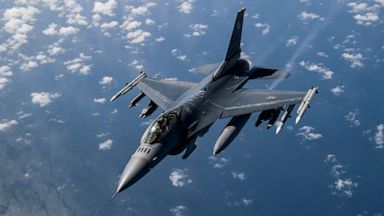While the Russia-Ukraine conflict continues and a former F-16 pilot criticizes Su-35 jets, the F-16 Fighting Falcons of the US Air Force stationed in South Korea have commenced receiving crucial upgrades to their radar and avionics systems, aiming to enhance their operational capabilities.
According to the US Air Force, an upgraded Fighting Falcon, Wolf Pack Tail 021, rejoined the 8th Fighter Wing’s Pack on April 4 after undergoing the initial phase of one of the most extensive modernization projects in the history of the F-16 program.
The primary unit stationed at Kunsan Air Base in the Republic of Korea, falling under the jurisdiction of the Seventh Air Force, is the 8th Fighter Wing of the United States Air Force.
As part of the Post Block Integration Team project, these enhancements are being implemented on the F-16s. The project aims to increase the lethality and survivability of the F-16s to meet the requirements of current and future missions.

The upgrade primarily focuses on the APG-83 Scalable Agile Beam Radar (SABR) equipped with an Active Electronically Scanned Array (AESA) and the Center Display Unit (CDU).
The US Air Force states that these upgrades will provide pilots with improved situational awareness, enhancing the weapon system’s survivability and accuracy.
Col. John D. Caldwell, the Vice Commander of the 8th Fighter Wing, emphasized the significance of this upgrade, given the expected operational lifespan of the F-16 until the 2040s, to ensure that the US Air Force remains up-to-date in response to the evolving threat environment.
WP Tail 021 has become the first F-16 aircraft belonging to the 7th Air Force to resume flight operations with PoBIT upgrades. The rest of the fleet will also receive these enhancements, which will strengthen the US Air Force’s ability to maintain a free and open Indo-Pacific region while ensuring stability on the Korean Peninsula.

Captain Michael C. Durham, Weapons Tactics Officer of the 8th Operations Support Squadron, highlights that the avionics upgrades enable pilots to fully utilize the advanced weapons and sensors of the F-16. This upgrade facilitates high-speed data transmission, high-resolution video capabilities, and ultimately aids pilots in making tactical decisions.
With the radar upgrade, the F-16 can now track a larger number of targets from longer distances, even in challenging conditions where cooperation may be limited. The integration of synthetic aperture radar mapping enhances the aircraft’s all-weather capabilities, improving target identification and engagement.

Regarding recent headlines, Ukraine has requested F-16s from the US and its allies to defend its skies against Russian attacks, as they claim their outdated Soviet-era fighter jets are inadequate against the more advanced Russian fighter jets, particularly the Su-35. Conversely, the Russian government consistently asserts that Western fighter jets cannot compete with its advanced warplanes.
However, Retired Lieutenant Colonel Dan Hampton, also known as Two Dogs, a highly skilled F-16 pilot in the US Air Force, believes that the Russian military holds misconceptions about modern air warfare. He argues that Russia would face defeat if they attempt to match the capabilities of the F-16. Hampton explains that air combat can be categorized into long-range battles using sensors and radar, as well as close-range engagements.
He notes that the radar technology used in the Su-35 is outdated and was developed three decades ago, while the F-16’s radar is more sophisticated, providing pilots with better long-range target engagement capabilities. The F-16’s radar also enables pilots to track multiple targets and engage them with multiple missiles.

In terms of close combat, Hampton highlights the F-16’s advantage due to its compact size and streamlined design, making it less visible than other fighters such as the MiG-29. Additionally, he emphasizes the F-16’s high maneuverability, which gives it an edge in dogfights. Hampton emphasizes the importance of air combat tactics in such conflicts.
Based on his understanding of aerial battles in Ukraine and his previous training with Russian pilots, Hampton observes that the Russians rely on numerical superiority rather than displaying the ingenuity demonstrated by Ukrainian pilots. He concludes by stating, “Russian pilots went straight up and thought this would create problems with our radars – and we would not see them. But we just shot them down every time. We were just smiling and shooting at them.”
Hampton recently expressed his willingness to fight for Ukraine if private military contractors were permitted by the US and Ukrainian governments. He has previously criticized Russian fighters, referring to them as “junk” suitable only for air shows.